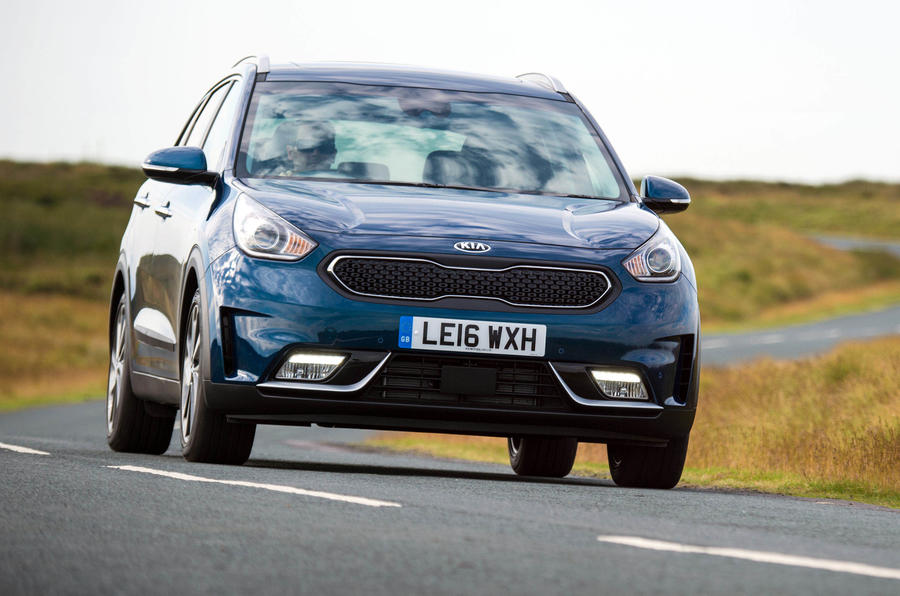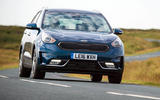What is it?
The Kia Niro represents its Korean maker killing two birds with one cleverly chucked stone. The firm’s first dedicated hybrid model (one available only with an electrified powertrain, like a Toyota Prius) is Kia’s first hybrid of any kind offered for sale in the UK, and also a new member of the enduringly popular ‘crossover’ class of compact pseudo-SUVs. That means the Niro has an iron in the roaring fire of not one, but two of Europe’s most lucrative growth areas.
Built on an all-new platform devoted to hybrid and all-electric models, the Niro uses weight-saving aluminium for its bonnet, tailgate and front bumper rail. A lightweight high-voltage lithium-ion battery housed under the back seats shuffles electrical power back and forth from a 43bhp electric motor, the latter assisting a 1.6-litre direct-injection petrol engine, which drives into a six-speed twin-clutch automatic gearbox, and then exclusively to the front wheels.
Kia claims combined peak ‘system’ outputs of 139bhp and 195lb ft for the Niro (the latter something of a fib, since it’s an ‘at-the-wheels’ figure only accessible in first gear). Buy one in either of the bottom of four trim levels – running on 16in alloy wheels and Michelin Energysaver tyres – and it’ll be rated at just 88g/km of CO2 and 74.3mpg.
Opt for either of the more expensive model trims in the Niro range and the car comes instead on 18in alloys and Michelin Pilot Sport 4 tyres, taking the edge off the car’s emissions and economy performance considerably. It’s the top-of-the-range First Edition version that Kia provided for our first UK test.
What's it like?
Having lesser dimensions than the firm’s Sportage, the Niro still strikes you as a quite typically proportioned, jacked-up family hatchback – except that it isn’t as high-rise as the crossover class norm. Standing just 1535mm tall, the car’s roofline is considerably closer in height to that of a Nissan Pulsar than a Nissan Qashqai, and to get into the car you need to drop down into the seat in a way that plenty of crossover buyers would prefer to avoid.
Once you’re onboard, though, space and comfort levels are both good. Kia’s standard leather seats are a little flat and hard, but there’s ample room for larger adults in both rows, with second-row head room particularly generous. Boot space is well up to class standards, too, and unrestricted by the car’s hybrid powertrain.
The Niro has a well-structured dash design with instruments and infotainment screen on the same level, plus easy-to-use ventilation and audio system controls, and clear, readable instruments. Material quality is good, with soft-touch mouldings predominating at shoulder level, and where harder plastics are found they’re solid and well-finished.
At all times a smooth and quiet car on the move, the Niro has excellent mechanical refinement and rewards a relaxed driving style. It defaults to an Eco driving mode that configures the accelerator and gearbox pedal for a gentle rate of progess, and shuts off the combustion engine for significant periods at both town and B-road speeds.
Move the gearlever across the shift gate and you activate a Sport driving mode that makes for stronger initial throttle response, weightier steering and greater linearity to the car’s performance overall. But really, your choice is between ‘slow’ and ‘very slow’. Kia’s preference for a twin-clutch gearbox where you might otherwise have found a CVT does mean there’s none of the ‘elastic band’ over-revving you find in certain petrol-electric cars, but generally the car feels about as willing to be chivvied along as a heavily-laden packhorse.















































Join the debate
Add your comment
KIA NEEROO
KIA NEEROO
KIA NEEROO